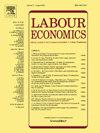Reducing the child penalty by incentivizing maternal part-time work?
IF 2.6
2区 经济学
Q2 ECONOMICS
引用次数: 0
Abstract
Governments worldwide are discussing ways to increase maternal labor market participation and to reduce the child penalty. This study analyzes the long run effects of a paid parental leave reform in Germany, a country characterized by high rates of maternal part-time employment after childbirth. The reform introduced additional financial incentives for mothers to engage in part-time work during the first two years following childbirth. Using German social security records, we exploit the fact that only mothers whose child is born in or after July 2015 are eligible for the new part-time parental leave option in a Difference-in-Differences strategy. We find that the policy increased the probability that high-income mothers return to work during the first year after child birth by 2.1–2.8 percentage points ( 15%–20%). However, the policy does not affect maternal employment along the extensive or intensive margin (part-time or full-time work) in the long run (i.e. up to 4.5 years after child). This indicates that while the reform successfully encourages early part-time return to work among high-income mothers, it does not significantly reduce the child penalty. However, it does also not trap mothers in part-time employment.
通过鼓励母亲兼职来减少对孩子的惩罚?
世界各国政府正在讨论提高产妇劳动力市场参与度和减少对儿童的惩罚的方法。本研究分析了德国带薪育儿假改革的长期影响,德国的特点是产妇在分娩后兼职工作的比例很高。这项改革为在分娩后的头两年从事非全日制工作的母亲提供了额外的财政奖励。利用德国社会保障记录,我们利用了这样一个事实,即只有在2015年7月或之后出生的孩子的母亲才有资格在差异中的差异策略中享受新的兼职育儿假选项。我们发现,该政策将高收入母亲在孩子出生后第一年重返工作岗位的概率提高了2.1-2.8个百分点(≈15%-20%)。然而,从长远来看,该政策并不影响产妇在广泛或密集范围内的就业(兼职或全职工作)(即生育后长达4.5年)。这表明,虽然改革成功地鼓励高收入母亲早日兼职工作,但并没有显著减少对孩子的惩罚。然而,它也没有让母亲们陷入兼职工作的困境。
本文章由计算机程序翻译,如有差异,请以英文原文为准。
求助全文
约1分钟内获得全文
求助全文
来源期刊

Labour Economics
ECONOMICS-
CiteScore
3.60
自引率
8.30%
发文量
142
期刊介绍:
Labour Economics is devoted to publishing research in the field of labour economics both on the microeconomic and on the macroeconomic level, in a balanced mix of theory, empirical testing and policy applications. It gives due recognition to analysis and explanation of institutional arrangements of national labour markets and the impact of these institutions on labour market outcomes.
 求助内容:
求助内容: 应助结果提醒方式:
应助结果提醒方式:


